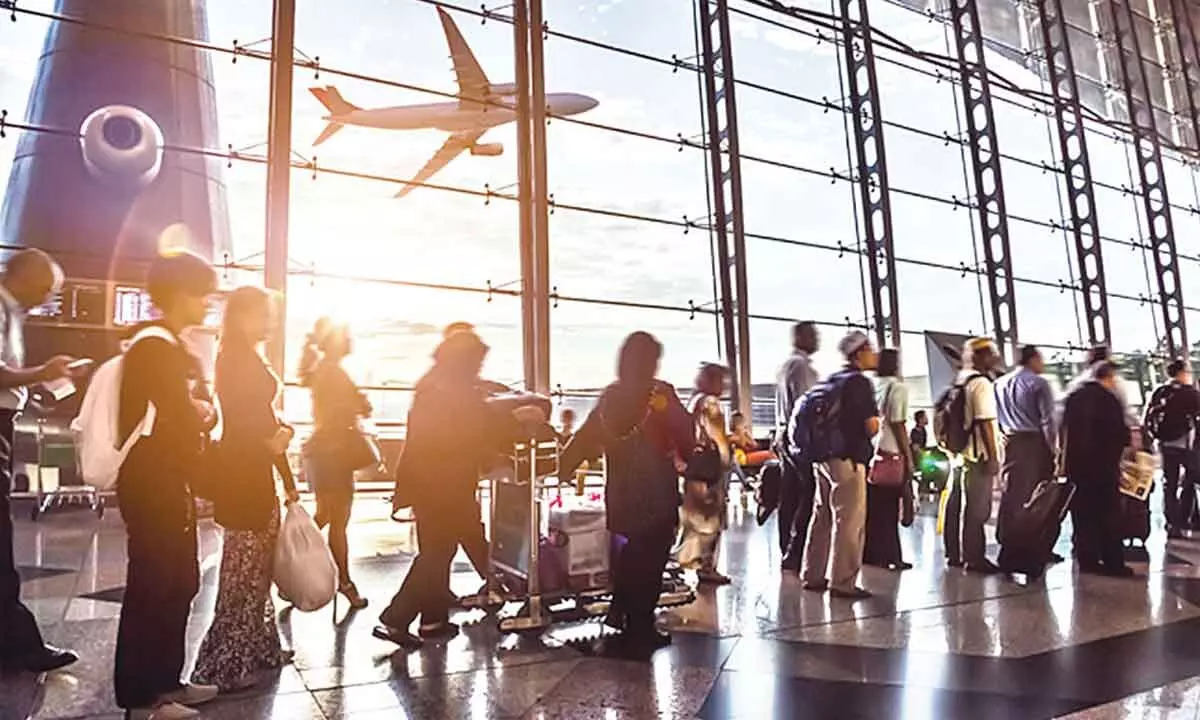International travel drives May air traffic recovery
Global traffic is now at 68.7% of pre-crisis levels. Domestic traffic for May 2022 was up 0.2% compared to the year-ago period
image for illustrative purpose

This year, IATA forecasts that commercial passenger traffic will be roughly a third below pre-pandemic levels, however, there is still a lot of debate around the pace and shape of recovery. In business aviation, the market is experiencing a structural expansion, as evidenced by the record 3.3 million flights worldwide in 2021.
Passenger data for May 2022 showed that the recovery in air travel accelerated heading into the busy Northern Hemisphere summer travel season.
Total traffic in May 2022 (measured in revenue passenger kilometers or RPKs) was up 83.1 per cent compared to May 2021, largely driven by the strong recovery in international traffic. Global traffic is now at 68.7 per cent of pre-crisis levels.
Domestic traffic for May 2022 was up 0.2 per cent compared to the year-ago period. Significant improvements in many markets were masked by a 73.2 per cent year-on-year decline in the Chinese domestic market due to Covid-19 related restrictions. May 2022 domestic traffic was 76.7 per cent of May 2019.
International traffic rose 325.8 per cent versus May 2021. The easing of travel restrictions in most parts of Asia is accelerating the recovery of international travel. May 2022 international RPKs reached 64.1 per cent of May 2019 levels.
"The travel recovery continues to gather momentum. People need to travel. And when governments remove Covid-19 restrictions, they do. Many major international route areas – including within Europe and the Middle East-North America routes - are already exceeding pre-Covid-19 levels. Completely removing all Covid-19 restrictions is the way forward, with Australia being the latest to do so this week. The major exception to the optimism of this rebound in travel is China, which saw a dramatic 73.2 per cent fall in domestic travel compared to the previous year. Its continuing zero-Covid policy is out-of-step with the rest of the world and it shows in the dramatically slower recovery of China-related travel," said Willie Walsh, IATA's Director General.
International passenger markets
European carriers' May traffic rose 412.3 per cent versus May 2021. Capacity rose 221.3 per cent, and load factor climbed 30.1 percentage points to 80.6 per cent. The impact of the war in Ukraine remained limited to areas directly impacted.
Asia-Pacific airlines had a 453.3 per cent rise in May traffic compared to May 2021. This is significantly higher than the 295.3 per cent year-on-year gain registered in April 2022. Capacity rose 118.8 per cent and the load factor was up 43.6 percentage points to 72.1 per cent. Improvements in the region are being driven by reduced restrictions in most of the region's markets, except China.
Middle Eastern airlines' traffic rose 317.2 per cent in May compared to May 2021. May capacity rose 115.7 per cent versus the year-ago period, and load factor climbed 37.1 percentage points to 76.8 per cent. The progressive re-opening of Asian markets is boosting traffic through Gulf hubs.
North American carriers experienced a 203.4 per cent traffic rise in May versus the 2021 period. Capacity rose 101.1 per cent, and load factor climbed 27.1 percentage points to 80.3 per cent. With most restrictions removed for travelers from this region, tourism and a high willingness to travel continue to foster the international recovery as several other routes areas are now outperforming 2019 results.
Latin American airlines' May traffic rose 180.5 per cent compared to the same month in 2021. May capacity rose 135.3 per cent and load factor increased 13.5 percentage points to 83.4 per cent, which was the highest load factor among the regions for the 20th consecutive month. Some routes, including those from Central America to Europe and to North America, are outperforming 2019 levels.
African airlines had a 134.9 per cent rise in May RPKs versus a year ago. May 2022 capacity was up 78.5 per cent and load factor climbed 16.4 percentage points to 68.4 per cent, the lowest among regions.
India's domestic RPKs rose 405.7 per cent year-on-year in May, compared to the 78.6 per cent increase recorded in April. In May 2021, India had experienced the country's most severe Covid-19 outbreak.
US domestic traffic was up 26.1 per cent in May, compared to May 2021. In the longer term, governments must improve their understanding of how aviation operates and work more closely with airports and airlines. Having created so much uncertainty with knee-jerk Covid-19 policy flip-flops and avoiding most opportunities to work in unison based on global standards, their actions did little to enable a smooth ramping-up of activity. And it is unacceptable that the industry is now facing a potential punitive regulatory deluge as several governments fill their post-Covid-19 regulatory calendars. Aviation has delivered its best when governments and industry work together to agree and implement global standards. That axiom is as true post-Covid-19 as it was in the century before." said Walsh.

